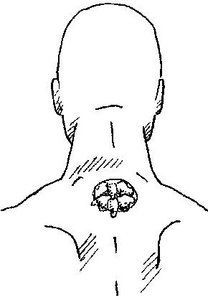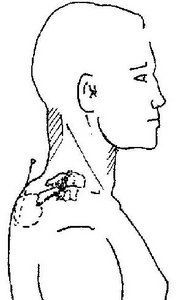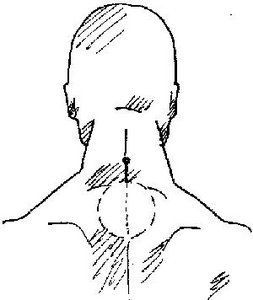One of the longest nerves in the body is known as the vagus nerve (VN). The VN is the 10th pair of cranial nerves that originates at the brain stem in the medulla oblongata. This nerve is part of the parasympathetic nervous system, which is a part of the ANS. Research suggests ear acupuncture can activate the VN.
GV14 (Dazhui): Big Vertebrae-Central Reunion Point
In any practitioner's repertoire of points, GV14 (dazhui) should come to the fore as a point of choice for strengthening the body's yang if it is deficient or decreasing yang if it is excessive. More often than not, deficiency is our most common clinical scenario. However, both excess and deficiency can manifest in patients, so we should not forget this highly effective point for such cases.
This article addresses the treatment of GV14 with needling, moxibustion, bleeding and cupping for the clinical manifestations of deficient or excess conditions. First, we will begin with a perusal of the point's clinical energetics to understand why it would be chosen as a point of treatment.
As a point on the governing vessel channel (the channel that governs the body's yang), GV14 plays a role in regulating yang. It is the meeting point of all yang channels. As such, it strongly tonifies wei qi and stimulates the adrenal cortex. It opens to the exterior, opens the yang, clears the brain, and calms the spirit. It can also dramatically increase white blood cell production. It is viewed as an evil wind reflex, meaning that it s a common area for the entry of exogenous wind.
Governing vessel 14 has been called the point of greatest yang in the body. Anatomically, it is located on the posterior aspect of the body, in the depression below the spinous process of the seventh cervical vertebrae, approximately at the level of the shoulder. If yang is deficient in a patient, this in an excellent point to needle or apply moxibustion to. If yang is excessive, the point can likewise be needled, bled, or even cupped.
Excess conditions include febrile disease, malaria, blood diseases, neck pain and rigidity, back stiffness, psychosis, epilepsy, seizures, pneumonia, schizophrenia, bronchitis, asthma, hepatitis and eczema. In excess conditions, the point must be needled obliquely up to the standard depth of 0.5-1.0 cun, with a dispersion technique such as a large amplitude and speed of rotation, or with a vigorous lift/thrust needle technique with an emphasis on the withdrawal.
In addition, if heat manifestations exist such as fever, heat in the lungs, and labored breathing with yellow mucus as in the case of pneumonia, the point can be bled with a #28 or #30 gauge filiform needle. Quickly insert the needle .01 cun into the point and obtain 1-2 drops of blood. This technique will reduce heat/fire in the body. The application of a glass cup over the point after it has been bled will further expel blood to assist in a quicker resolution of the problem. Wear gloves when bleeding and/or cupping the point, and sterilize all equipment properly after bleeding.
When the patient is deficient, needling may also be employed using a tonification technique such as small amplitude of rotation and slow speed when needling the point. Needle obliquely up to the standard depth of 0.5-1.0 cun. Deficiency diseases include afternoon fever, pulmonary tuberculosis, cough, asthma, hemiplegia, pain in the back of the shoulder, tidal fever, hot sensations in the bones with recurrent fever, chills, and leukopenia (low white blood cell count).
Generous and frequent use of moxibustion may also be incorporated into treatment to augment yang deficiency. It is pleasant and soothing to the patient and has the clinical effect of raising white blood cell count.
Moxibustion is an excellent treatment for patients with weak immunity such as those with chronic fatigue, those undergoing chemotherapy, and patients with generalized kidney yang deficiency (a condition manifesting itself with low energy, the desire for sleep, cold hands and feet, and a tendency to catch colds easily). Moxa may be applied in a variety of forms, including needles, an indirect moxa pole, a direct mini-thread moxa, a tiger thermie warmer or an indirect moxa burner. Regardless of the method of delivery, administer moxa for 3-5 minutes per session. Treat subsequently according to signs and symptoms. Monitor for signs of heat aggravation, and discontinue if signs develop.
In cases of severe kidney yang deficiency, abnormal neck pathology (sometimes called a fat pad) can develop at GV14. As we have seen, dazhui is the point of greatest yang in the body. Fat accumulation is evidence of the failure of kidney yang to dominate water metabolism. The mound is water tied up in the form of damp fat. This condition should always be treated when seeing patients due to its clinical significance.
With the patient in a sitting position, inspect the GV14 area. The fat pad extends around the point in a round or oval pattern. It is indicated visually as a distinct mound. Confirm the mound by grasping the area. Do not confuse this with a dowager's hump.
Patients who exhibit this problem may have other signs and symptoms of kidney yang xu such as excess weight, respiratory problems, loose stools with undigested food, lethargy, poor skin color, gas, abdominal distention, low blood pressure and cold feet. Patients with hypothyroidism present with this demarcation as well. Patients with a history of asthma or bronchitis, or those who have used steroids such as prednisone, may suffer from adrenal insufficiency. Of all groups, steroid users most frequently develop this distinctive feature.
Another disorder in which a fat pad develops is Cushing's syndrome. It is an uncommon condition which sometimes occurs in people undergoing long-term corticosteroid treatment.1
With Cushing's syndrome, the face becomes fatter than normal, usually rounder and red. The body also becomes fatter; a fat pad often develops between the shoulder blades, making them appear round-shouldered. At the same time, muscle tone is lost from the arms and legs. Patients will feel weak and tired; their skin may become thinner; and bruises sometimes appear spontaneously on the arms and legs. The bones become thin and fracture easily.
A feature I call a preclinical fat pad also appears in its formative stages. The texture of the skin is commonly thick or fatty. It is more characteristic of patients with a lesser degree of kidney yang deficiency than the more overt presentation patients with adrenal exhaustion have. It should be treated in the same manner, and its clinical significance is only one of degree.
Regardless of the diagnosis, to treat the problem, grasp the area and insert a fine needle subcutaneously downward through the pad. Do not come out the other side. Do not obtain qi, but use a lift and thrust technique to stimulate the point. Retain the needle for 10-20 minutes. You may also use moxa around the borders of the area. Apply moxa around the pad for about three minutes using a moving technique. The area should get mildly red to red. Figure 1 illustrates the fat pad at GV14; Figures 2A and 2B demonstrate how to needle it.



A supplement to this treatment is to apply moxa to GV4 (mingmen), the gate of life. It is a primary point to tonify kidney yang. Mingmen may be needled in the standard manner (perpendicular 0.5-1.0 cun), but the application of moxa is preferable for yang deficiency. Moxa can be applied to the needle, or other methods can be used similar to those for GV14.
Reference
- Clayman C (ed.) The American Medical Association Family Medical Guide, 3rd ed. New York: Random House, 1994, p. 564.



